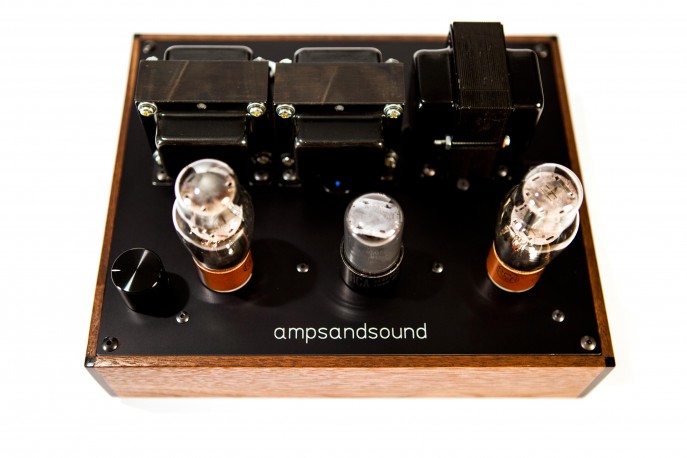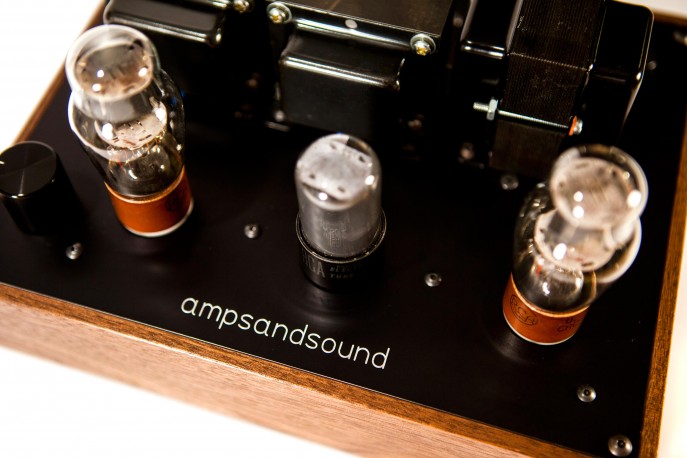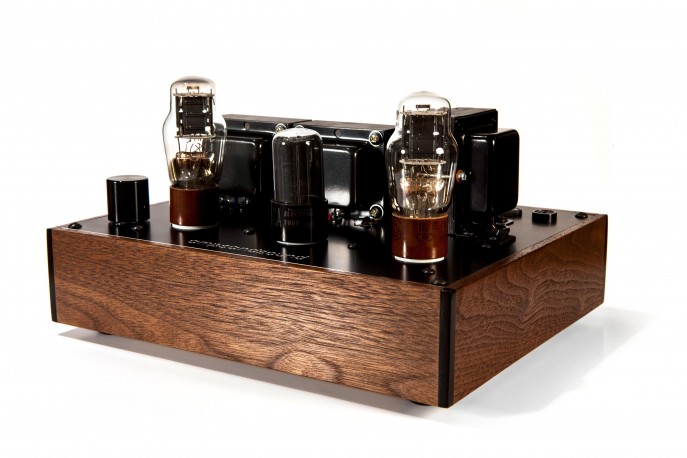For the longest time, I’ve been a “tube-guy”. I’ve had tube based amplifiers in my rack in various forms for over 20 years. I’ve really enjoyed the ability to “tune” the amplifier to my personal preferences. The ability to get the “perfect” sound for a pair of headphones or speakers is one big advantage that tube-based amplifiers can offer. But that can lead one down the “rabbit hole” of constantly trolling the internet for older and rarer NOS (New Old Stock) vacuum tubes from the 1930s and 1940s.
But once you get the tube combination “right”, the magic that a well-designed and built tube amplifier can offer is very special indeed. I would make the comparison of digital audio vs. vinyl when comparing solid state to tube amplifiers respectively. Tube amplifiers can offer a very natural and musical sound when compared to the usually more clinical approach solid state based amplifiers. Now for the past 3+ years, I’ve gone over to the “dark side” (literally as my solid state amps no longer have that great warm glow given off by the vacuum tubes) and have gone all-solid state in my setup. So when the opportunity to review a new tube headphone amplifier came up, I was more than happy to oblige and see what I’ve been missing for the past number of years.
This amplifier was designed and built by Amps & Sound; a company located in California, USA. The company was founded by Justin Weber and he is the lead designer for all of his products. In my discussions with Justin, his passion for amplifier design and tube amplifiers really came through. He certainly was very knowledgeable of many different approaches to designing amplifier circuits and while his first products released were focused on 2 channel full speaker setups, he has made the foray into personal audio with the release of the new tube-based headphone amplifier: The Kenzie.

Photos don’t really do this amplifier full justice. Yes, the photos do look quite impressive, but when you actually get the amplifier in your hands, the retro-styling and quality of construction (both inside and out) really show that a lot of thought and care went into it. The newly introduced Kenzie is a not just a beautiful amplifier to look at, but it brings the goods with regards to the sonic performance (more on that later). The amplifier is based on a 1626, known as “the poor man’s 300b” vacuum tube, which has all the same great soundstaging, layering and musicality without having to spend an arm and a leg every few years. The costs of the 1626 vacuum tubes used in the Kenzie are ridiculously affordable. In fact, a dozen of NOS Tung-Sols can be had for as little as $80 US for the lot. This vacuum tube was primarily used in WWII as a transmitter tube in radar installations. So as a result of its military background, it is a very robust tube. While I am quite familiar with its big brother (300b tube), this was my first experience with the 1626.
The amplifier is based on the well regarded “darling circuit” and the Kenzie utilizes custom wound ultra-high quality output transformers which in turn provide a wide frequency range and dynamic sound. Furthermore, Amps & Sound included two separate headphone outputs. The 32 ohm 1/4” stereo headphone output is for low impedance headphones (like the 32 ohm Grado PS1000e) while the 600 ohm output is for higher impedance headphones (like the 600 ohm Beyerdynamics T1 or 300 ohm Sennheiser HD800). As a result of having both a low and high output impedance option, the amplifier can be more robust in driving a wider range of different headphones regardless of their impedances and still offer a more suitable damping factor. I am a big fan of headphone amplifiers that offer this functionality and I’m glad to see that the folks at ampsandsound have included this in the Kenzie.

The amplifier has one pair of input RCA (un-balanced) inputs to take the inputs from your source such as a digital-to-analog converter or CD player. As well, the Kenzie is equipped with an Alps volume pot and feels silky smooth when turning up the volume. Even though the $1500 US price is on the higher side of things, when taken as a whole from a design and construction point of view, the Kenzie is more than worth it in my opinion and competes very strongly with other tube amplifiers in this price range. Sonically, as I’ll touch upon later, the entire package is quite impressive and the value proposition of this product is definitely high!
The specifications of the Kenzie amplifier as noted by the manufacturer are:
Input impedance is 475 kohm, 0.5V for full power:
Noise with pot fully counterclockwise is 5mV RMS (Average)
All measured at the 32 ohm tap. All power measurements are in RMS
100mW 20Hz (-1dB) to 17.7 kHz (-3dB)
150mW 20Hz (-1dB) to 14.8 kHz (-3dB)
200mW 20Hz (-1.25dB) to 16.7 kHz (-3dB)
Setting up the Kenzie was a snap. Luckily my GS-X Mk2 has an RCA loop-out connection. So I pulled out my Nordost Blue Heaven RCA cables and ran them into the Kenzie amplifier. With this review sample, ampsandsound also included an upgrade power cord that is available as an optional upgrade to the stock power cord. This thing is an anaconda of a power cord: an 8 foot, 10 gage beast using OFC copper. I simply plugged in the stock supplied power and driver tubes, plugged in the amplifier and I was off to the races. I allowed the amplifier to warm up for 20 minutes or so.
My many years of previous ownership of various tube amplifiers have consistently shown me that warm up is a must in order to get the best sound quality as the tubes come up to temperature and the voltages and currents settle in to their optimal settings. Once I got things fired up, the natural tube glow showcased what a beautiful amplifier the Kenzie was in its full splendor. The retro-wood finish and the vacuum tubes really made for a visually pleasing experience that perfectly complimented the audible experience that was to follow.
The first pair of headphones that I selected were the newly released Beyerdynamics T1 Generation 2 headphones. I have previously reviewed these wonderful headphones and through my experiences with them (and their Generation 1 predecessor), I always felt they truly shone when played with a great tube amplifier. Previously, the Mapletree Ear+HD, Woo Audio WA2 or WA22 tube amplifiers were simply brilliant with the first generation T1s and I was excited to see how the second generation T1s would play with the Kenzie.
I selected Roger Waters’ newly released live album of his most recent “The Wall Tour”. I was lucky enough to catch his concert here in Toronto 3 years ago and it was certainly a magical night that I won’t forget. As soon as I plugged in the 600 ohm T1s into the high output impedance headphone jack, I barely noticed the noise floor. Sometimes tube amplifiers are not the greatest at having a black background as some tube-hum can sneak through. The Kenzie here was almost dead silent and I had to really focus and listen carefully to hear just the slightest background noise floor from the 1626 tubes. This is definitely one of the quietest headphone tube amplifiers I’ve come across with full sized headphones. I did try a pair of PSB M4U 4 IEMs though and I would not recommend this amplifier for those using sensitive in-ear monitors as this noise floor was too prevalent for my tastes. But for full sized headphones, whether they were my super sensitive Oppo PM-3, Grado PS1000e headphones, or high impedance headphones like the Sennheiser HD800 or Beyerdynamics T1, the Kenzie was very good in terms of a very low noise floor.
As soon as “In the Flesh” started up, I knew I was going to be in for a real treat. The 2nd generation T1s have incredible dynamics, details and soundstaging capabilities and when paired with the Kenzie they really shined! My primary amplifier for them is my own HeadAmp GS-X Mk2 and I’ve got some extensive experience with Beyerdynamics’ own A 2 amplifier. Both are outstanding at driving these headphones with authority and the upmost in clarity. But with some recordings, the T1s can come off as a bit clinical. That’s where the Kenzie really comes through. I get to have outstanding punch, realism and sound staging, but an incredible musicality that is sometimes missing with these other two solid state amplifiers.
I would classify the Kenzie as a very clean and quick tube amplifier. Sloppy and slow it was most certainly not. So if you’re looking for a euphonic tube amplifier that colours the sound with an enveloping warmth, this is not the Kenzie. Rather it is a very fast and detailed amplifier that digs deep into the recording to pull out the smallest nuances and micro-details and is still very quick and nimble. But there is a touch of euphony there that offers a very pleasing presentation that never becomes fatiguing or tiresome with extended use. Comfortably Numb was simply brilliant. The T1/Kenzie combination was as good as I’ve heard these headphones sound; the bass texturing was simply on another level. Roger’s vocals were brilliant and the treble was not pushed back or lacking in any way; nor was it strident or overly portrayed. I got goose bumps listening to this recording with this setup; it really was just as if I was there a few years back with my wife and having the time of my life.

I then switched to my Sennheiser HD800 headphones. I’ve always found these headphones quite difficult to drive properly. I’m not referring to power levels as they can be played very loudly from even portable amplifiers; instead, I’m referring to getting them to sound “right”. This is the challenge with these headphones. I’ve owned my pair for about 5 years and many amplifiers have come and gone and most have not been able to live up to this challenge. When the upstream setup is not properly thought out, the HD800s can come off as “thin, clinical, bass-lite and overly treble-centric”. But if one gets the source/DAC/amplifier “right”, then the HD800s will reward you in spades and stand out as one of the very best pair of headphones money can buy. So for this review, I selected two DSD albums that I often select for reviews. The first was Gustav Mahler’s Symphony No. 5 by the Netherlands Philharmonic Orchestra. I was so thoroughly impressed with the ampsandsound Kenzie and HD800s that I actually listened to the recording twice back-to-back. The sense of spacing and the precision of each musician in the sound scape were simply brilliant. The HD800s did not come off as “clinical” or “dry” in this setup, instead an enveloping sound was readily apparent from the outset. The Kenzie added that necessary “warmth” to the HD800s to make them a very pleasing experience while not getting in the way of the music and colouring it with its own personality. This is a very hard line to straddle and some amplifiers are good at one or the other, but not both. The Woo Audio WA22 is a very euphonic amplifier and pairs quite nicely with the HD800s, but over time and with recordings, its euphonic nature really does creep into the experience and smooths instruments too close together and rounds off the edges to a point where some of the realism is sacrificed. The Kenzie however manages to straddle this line of being true to the recording and still offers a very musical and pleasing presentation with these finicky headphones.

I then switched over to Shelby Lynne’s: “Just a Little Lovin’” (also a DSD file) played through my Hugo TT as a DAC feeding the Kenzie amplifier and the positive trend certainly continued. The performance was intoxicating. The combination of the HD800s and Kenzie amplifier was simply magical. The smallest details and precision of the twice as expensive HeadAmp GS-X Mk2 was slighltly diminished, but what you do gain is a sense of musicality and warmth that is incredibly enjoyable. However, unlike the Woo WA22, the Kenzie does not sacrifice too much in this regard for the sake of a pleasing experience. It can definitely hold its own weight here and is quite comparable to other great $1500 solid state amplifiers.
I don’t want to prejudice your opinion that this tube amplifier is warm and lush and rounds off the edges to a point where it overly colours the experience, because it most certainly does not. Instead, if you’re after a transparent and natural sounding amplifier that is also musical and enjoyable for long stretches without any listener fatigue, the Amps & Sound Kenzie just might be what you’re looking for. The bass on the Kenzie was simply fantastic with this album, it hit hard and did not overstay its welcome. The GS-X Mk2 was a bit better at the quickness and detail in this region, but for those looking for more heft down low, the Kenzie’s presentation was a bit more symphonic and sweet sounding. The mids were very liquid and up front. Shelby’s voice was spectacular and the Kenzie was easily able to keep up with her throughout her entire vocal range. The treble was surprisingly extended and clean and while a bit more melodious than a solid state amp, it never came off as overly subdued (which some tube based amplifiers that I’ve owned through the years can).
Switching in the 12SL7 to the more rare 2C52 tube, the signature of the Kenzie became a bit more lush and sweet. The presentation was certainly a bit closer to what I’ve come to expect from a tube amplifier. That’s the great thing as I mentioned with tube amps; you can “tune” your sound to your preference and something you cannot with a solid state amplifier. The 12SL7 tube is a wonderful contrast to the 1626 tube and you can virtually re-transform your sound on the fly. The differences are not night and day here, but the added warmth and sweetness with the 12SL7 is noticeable from the outset. It’s always great to have options!

Finally I listened to the same album by Shelby Lynne with my Grado PS1000e headphones using the 32 ohm jack. And I have to say that I was so impressed that my “go to” Grado headphone tube based amplifier recommendation will now have to change from the Mapletree Ear+HD to the Kenzie. It was simply outstanding; especially with the rare 2C52 tube. The added warmth and sweetness of these tubes complimented the brighter sounding Grados and helped better tune them for a very delightful experience. Fantastic bass, wonderfully rich mids and treble that while extended doesn’t come off as harsh or strident. The imaging that the Kenzie can portray with these headphones was truly holographic and one of the very best I’ve heard through them.
While new to the headphone amplifier market, ampsandsound has really done a fantastic job with the Kenzie! Everything from the packaging, to the outstanding retro-design and build quality and finally right up to the sonic goodness that this amplifier has to offer impressed me. The price point of $1500; while not cheap; performs with tube amplifiers costing considerably more. Throw in the fact that you won’t have to donate a kidney for a tube change and its win-win. The Kenzie has me rethinking my “all solid state” setup and has me definitely re-thinking about going back into tubes! Highly recommended!















Reply
Reply
Reply
Reply
Reply
Reply
Want to join discussion?
Feel free to contribute!